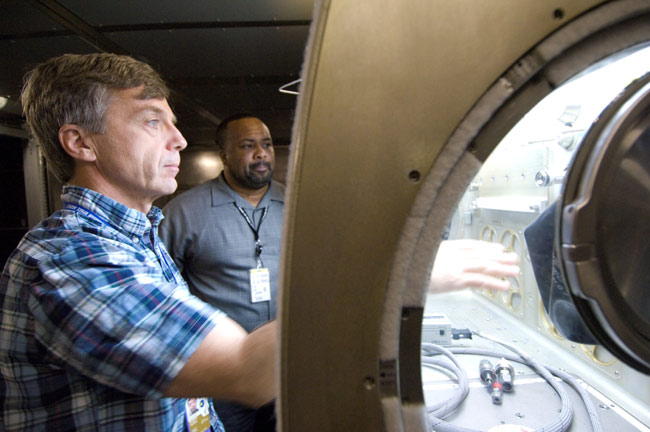NASA Shuffles Landing Plan for Some Station Astronauts

NASA has shuffledlanding options for two astronauts headed to International Space Station laterthis year due to shuttle launch date uncertainties.
The U.S.space agency announced a plan Tuesday to swap the return trips of Canadianastronaut Robert Thirsk and American spaceflyer Nicole Stott this fall toensure that future shuttle mission delays don?t extend Thirsk?s mission beyondthe traditional six-month duration.
?It wouldjust put him, timeline-wise, on an earlier return,? NASA spokesperson Nicole Cloutier-Lemasterstold SPACE.com from the agency?s Johnson Space Center in Houston. ?Thisis just kind of a preemptive measure in case there is more slippage.?
NASA has upto six space shuttle missions on its 2009 schedule, with the first currentlyslated to launch aboard Discovery noearlier than March 12 on a construction flight to the International SpaceStation. Discovery?s STS-119 mission has been waylaid since Feb. 12 due to fuelvalve concerns, but NASA officials have said that if they launch shuttle byaround March 13 the delay should not affect launch targets for the rest of theyear.
IfDiscovery is unable to launch in mid-March, NASA would have to stand down untilaround April 7 ? after a preplanned Russian Soyuz launchof a new crew to the space station. Delaying the spaceflight to April couldcause a ripple delays for subsequent shuttle missions, some of which areexpected to include station astronaut crew swaps.
Thirsk iscurrently slated to launch to the space station in late May aboard a RussianSoyuz rocket as part of the space station?s Expedition 20 ? thefirst six-person mission to the orbiting lab. He is Canada?s firstlong-duration astronaut and was slated to return home in November during NASA?sSTS-129 shuttle mission.
Stott,meanwhile, is currently scheduled to launch toward the station in August aboardDiscovery. She is also expected to join Expedition 20and was due to return aboard the Russian Soyuz spacecraft that will launchThirsk.
Breaking space news, the latest updates on rocket launches, skywatching events and more!
But NASA?sannouncement today will swap the return seats for Thirsk and Stott, with theCanadian spaceflyer landing on the Soyuz and the American returning home on theNovember shuttle flight.
NASAofficials said the swap ensures that Thirsk?s mission won?t exceed the typical six-monthduration for station astronauts, even if the November shuttle flight isdelayed. The longer astronauts fly in the weightless environment of space, themore exposure they have to space radiation, muscle and bone loss, the spaceagency has said.
?At thispoint we prefer to keep them [in space] around six months,? Cloutier-Lemasterssaid.
- Video - Space Station Acrobatics
- Video - Shaky Space Station
- Video - Drinking Water From Space Urine

Tariq is the award-winning Editor-in-Chief of Space.com and joined the team in 2001. He covers human spaceflight, as well as skywatching and entertainment. He became Space.com's Editor-in-Chief in 2019. Before joining Space.com, Tariq was a staff reporter for The Los Angeles Times covering education and city beats in La Habra, Fullerton and Huntington Beach. He's a recipient of the 2022 Harry Kolcum Award for excellence in space reporting and the 2025 Space Pioneer Award from the National Space Society. He is an Eagle Scout and Space Camp alum with journalism degrees from the USC and NYU. You can find Tariq at Space.com and as the co-host to the This Week In Space podcast on the TWiT network. To see his latest project, you can follow Tariq on Twitter @tariqjmalik.
